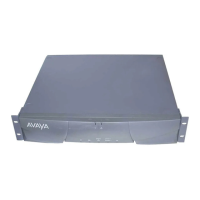Maintenance Commands
555-233-143
7-332 Issue 1 May 2002
Mode Commands/Communication Modes. This is a collection of both incoming
and outgoing bandwidth allocations for the multiplex. The Incoming data is the
rate at which the MCU thinks the endpoint is communicating based on the Bit-rate
Allocation Signal (BAS) codes received from the endpoint/codec and the
capabilities the MCU has declared. The Outgoing data is the rate from the MCU
toward the endpoint. The following are column definitions for this section of page
3.
The following are field definitions for the Mode Commands/Communication
Modes section of Page 3.
CONF The desired conference operating mode. This may be different from the
endpoint in (
EPT-IN) or endpoint out (EPT-OUT) modes.
CMD
labels for the various types of mode commands
STAT
indicates if the conference and the incoming modes are compatible. A value
of
y indicates mode compatibility; a value of n indicates that the modes are not
compatible.
EPT-IN
defines the communication modes coming in from an endpoint.
EPT-OUT
defines the communication modes sent out to an endpoint based on the
number of channels connected and the capabilities of the endpoint.
XRATE
One of the supported rates in Table 7-47:
Table 7-47. Supported Transfer Rates
XRATE Bandwidth of the Call
2x64 2B (2x56 or 2x64)
128 112 or 128 kbps
196 168 or 196 kbps
256 224 or 256 kbps
320 280 or 320 kbps
384 336 or 384 kbps
512 512 kbps
768 768 kbps
1472 1472 kbps
1536 1536 kbps‘
1920 1920 kbps
Continued on next page

